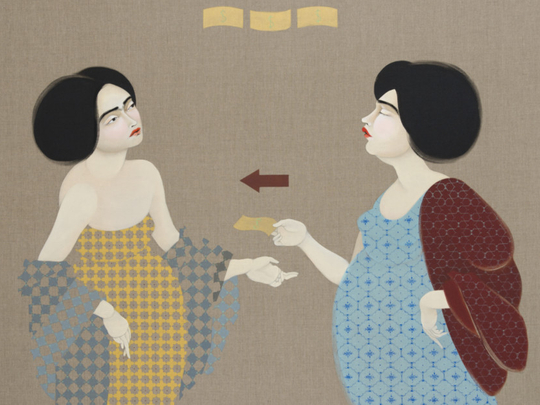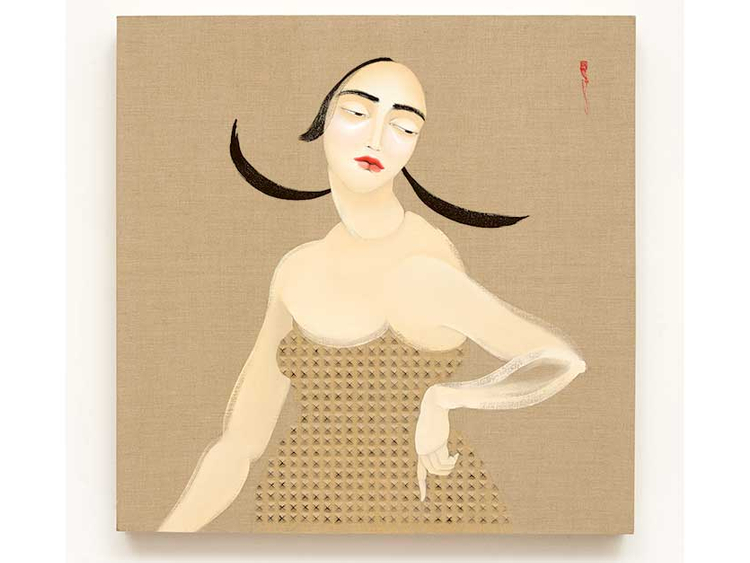
Hayv Kahraman can never forget the terrifying sound of the air raid siren that she heard as a child in Baghdad during the Iran-Iraq war and the first Gulf War. The memory of the sound still scares her. Yet, the Los Angeles-based artist searched for it, found it online and listened to it over and over again while she was working on the paintings for her latest exhibition, “Audible Inaudible”.
The title refers to a term coined by Martin Daughtry, an ethnomusicologist at NYU Abu Dhabi, to describe a violent sound that one gets accustomed to, making it almost inaudible.
For Kahraman, this numbing was an important part of the process of visually translating her sonic trauma into paintings. She has layered her personal narrative with references to visual and sonic elements used by the American army in conflict zones, and with gestures such as the insertion of sound-absorbing acoustic foam into her paintings to make a strong statement about the aggression of war vocabulary and the trauma of sound.
“Daughtry’s book ‘Listening to War: Sound, Music, Trauma and Survival in Wartime Iraq’ helped me to understand and analyse the notion of sound as a harbinger of doom. In the book he has mentioned a woman who told him that she would shield her children from the sound of the siren by holding them tight and pressing her arms over their ears. I liked this idea of the body becoming a shield against the sound, and hence decided to incorporate acoustic foam in the figures in my paintings on linen. It was a cathartic experience to make sharp, surgical cuts in my meticulously created paintings and push the foam in,” Kahraman says.
During her research on sound, Kahraman also learnt that sound can be manipulated to create sonic weaponry, such as LRADs (long range acoustic devices), which emit high decibel sounds that can even cause brain damage.
The artist has included references to these weapons, which have reportedly been used by the US Marines, in her work by making some of her paintings in the shape of an LRAD speaker, and making indentations of that shape in some works.
The body as object and subject is central to Kahraman’s work. Interestingly, the figures in this series are inspired by the Smart Cards, devised by the US Military to help its soldiers communicate through pictures with non-English speakers in conflict zones.
“These pamphlets, which I was able to order online, are designed to provide a visual vocabulary for US military personnel to deal with various situations such as getting directions, negotiating for information, and instructing suspects during personal searches,” Kahraman says.
In her paintings on linen, the artist has substituted the male figures on the Smart Cards with a stylised, almost ethereal version of her own body, but the poses are all based on the illustrations on the cards, and the titles of the paintings are derived from the phrases on the cards. She has also created her version of the cards on paper.
“This is my body, but these are not self-portraits. The bodies, the cuts on them and the foam that transforms them into armour represent the collective voice of survivors of extreme violence; of immigrants like me who struggle to be accepted and to belong; and of women who stoically bear every wound inflicted on them to emerge stronger,” Kahraman says.
The exhibition also includes two interactive works titled “Would You Like to Play”, featuring octagonal pieces of wood mounted on magnets on which Kahraman has painted geometrical patterns, splashes of red, symbols and figures based on the Smart Cards. The artist is inviting visitors to join “the game” and re-arrange the pieces.
Jyoti Kalsi is an arts-enthusiast based in Dubai.
“Audible Inaudible” will run at The Third Line, Al Quoz, until October 22.













